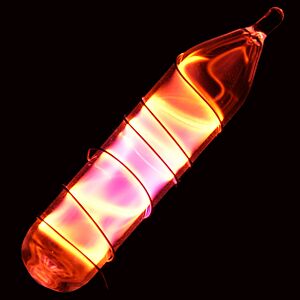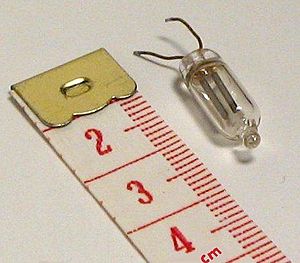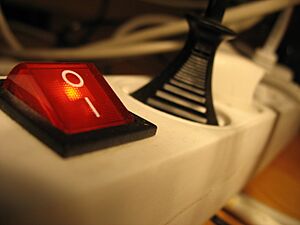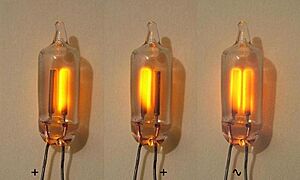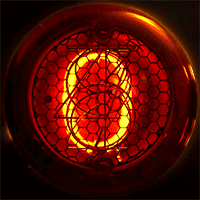Neon lamp facts for kids
A neon lamp is a special kind of light bulb that can glow in many different colors! It works by using special gases called noble gases inside a glass tube. When an electric current passes through these gases, they light up. For example, helium gas makes a light yellow color, while neon gas glows red or orange.
Neon lamps are most famous for making bright, colorful neon signs that you see on buildings and shops. Different gases create different colors, making these signs really eye-catching!
Contents
How Neon Lamps Make Colors
The color a neon lamp makes depends on the type of noble gas inside its tube. Each gas glows with a unique color when electricity flows through it.
For example:
- Neon gas glows red or orange.
- Helium gas glows light yellow.
- Argon gas glows purple or blue.
- Krypton gas glows pale violet or gray-white.
- Xenon gas glows blue or green.
Sometimes, other gases or special coatings are added to the inside of the glass tube to create even more colors!
A neon glow lamp is a smaller type of neon lamp, often seen as a little orange light bulb. Inside, there are two metal parts called electrodes. When electricity flows between these electrodes, the gas inside lights up.
What Are Neon Lamps Used For?
Neon lamps have many uses, from simple lights to more complex electronic parts.
Visual Indicators
Small neon lamps are often used as tiny lights to show if an electronic device or appliance is turned on. They are good for this because they use very little power and last a long time. You might see them on power strips, switches, or other electronic gadgets.
Voltage Testers
Most small neon lamps, like the common NE-2 type, need about 90 volts of electricity to light up. This special feature makes them useful as simple voltage testers.
Here's how they work:
- If you connect a neon lamp to a DC (direct current) source, only the negative side (called the cathode) will glow. This helps you figure out which part is negative.
- If you connect it to an AC (alternating current) source, both sides of the lamp will glow, one after the other, very quickly.
By looking at which part glows, you can tell if the electricity is AC or DC, and if it's DC, you can find its positive and negative sides.
Voltage Regulators
Neon lamps can also help keep electricity at a steady level. They can act like a safety device, making sure the voltage doesn't get too high. This helps protect other electronic parts from getting damaged by too much power.
Flashing Lights and Counters
Neon lamps can be used to make simple flashing light circuits. Because of how they turn on and off, they can be used to create blinking warning lights or even help with timing in older electronic devices.
In the past, special neon lamps called Dekatrons were used in early calculators and counting machines. These lamps could count numbers and show the count as a glowing light on different parts of the lamp.
Alphanumerical Displays
Before modern screens like those on your phone or computer, neon lamps were used to create numbers and letters in displays called Nixie tubes. These tubes had many shaped electrodes inside, and each shape would light up to form a number or symbol. Today, we mostly use LEDs (light-emitting diodes) and liquid crystal displays (LCDs) for displays.
Other Uses
In the 1930s, some old radios used neon lamps as "tuneons." These lamps would glow brighter when the radio was tuned correctly to a station.
Also, in the early days of television, neon lamps were sometimes used as the light source for mechanical TV displays because they could turn on and off very quickly.
Some artists even create special "novelty glow lamps" with electrodes shaped like flowers or leaves, making them beautiful decorative lights.
Related pages
Images for kids
-
A small NE-2 type neon lamp powered by alternating current (AC).
-
A General Electric NE-34 glow lamp, made around 1930.
-
Unlit and lit neon lamps (NE-2 type) and their light spectrum.
See also
 In Spanish: Lámpara de neón para niños
In Spanish: Lámpara de neón para niños


